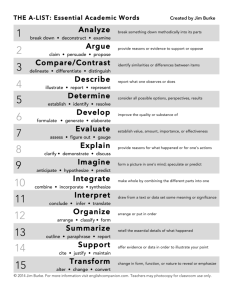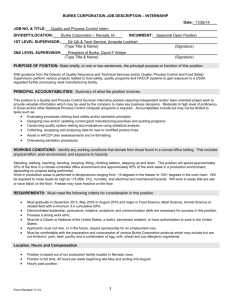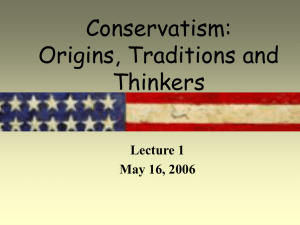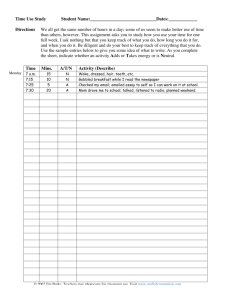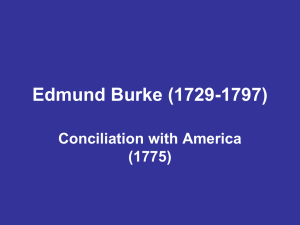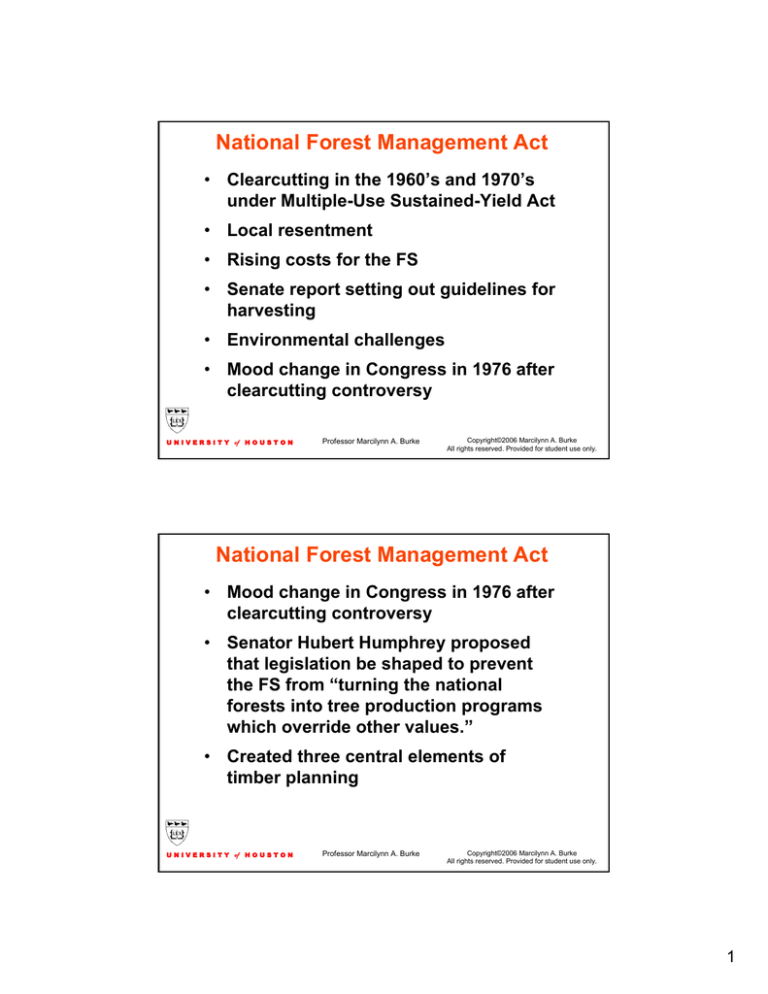
National Forest Management Act
• Clearcutting in the 1960’s and 1970’s
under Multiple-Use Sustained-Yield Act
• Local resentment
• Rising costs for the FS
• Senate report setting out guidelines for
harvesting
• Environmental challenges
• Mood change in Congress in 1976 after
clearcutting controversy
U N I V E R S I T Y of H O U S T O N
Professor Marcilynn A. Burke
Copyright©2006 Marcilynn A. Burke
All rights reserved. Provided for student use only.
National Forest Management Act
• Mood change in Congress in 1976 after
clearcutting controversy
• Senator Hubert Humphrey proposed
that legislation be shaped to prevent
the FS from “turning the national
forests into tree production programs
which override other values.”
• Created three central elements of
timber planning
U N I V E R S I T Y of H O U S T O N
Professor Marcilynn A. Burke
Copyright©2006 Marcilynn A. Burke
All rights reserved. Provided for student use only.
1
National Forest Management Act
Timber Planning
• Determining the suitable land base or
inventory
• Calculating the allowable cut, and
• Deciding upon the appropriate method
for harvesting and regenerating the
timber
U N I V E R S I T Y of H O U S T O N
Professor Marcilynn A. Burke
Copyright©2006 Marcilynn A. Burke
All rights reserved. Provided for student use only.
National Forest Management Act
Land Resource Management Plans
• LRMPs developed during the 1980’s
• Environmental challenges regarding
• NFMA
• NEPA
• APA
• ESA
U N I V E R S I T Y of H O U S T O N
Professor Marcilynn A. Burke
Copyright©2006 Marcilynn A. Burke
All rights reserved. Provided for student use only.
2
National Forest Management Act
LRMPs Cont’d
• 1990’s began revising plans to give
ecological sustainability a higher
priority
• Bush Administration delayed
implementation of the new rules
pending further study
U N I V E R S I T Y of H O U S T O N
Professor Marcilynn A. Burke
Copyright©2006 Marcilynn A. Burke
All rights reserved. Provided for student use only.
National Forest Management Act
Central Provisions
• Physical suitability
• Economic suitability: “below-cost
timber sales” issue
• Diversity
U N I V E R S I T Y of H O U S T O N
Professor Marcilynn A. Burke
Copyright©2006 Marcilynn A. Burke
All rights reserved. Provided for student use only.
3
National Forest Management Act
Physical Suitability:
16 U.S.C. § 1604(g)(3)(E)
•
Regulations and forest plans must
insure that timber will be harvests only
where—
i.
soil, slope, or other watershed
conditions will not be irreversibly
damaged;
ii.
there is assurance that such lands can
be adequately restocked within five
years after harvest; [and]
U N I V E R S I T Y of H O U S T O N
Professor Marcilynn A. Burke
Copyright©2006 Marcilynn A. Burke
All rights reserved. Provided for student use only.
National Forest Management Act
Physical Suitability Cont’d
iii. Protection is provided for . . . water
bodies . . . where harvests are likely to
seriously and adversely affect water
conditions or fish habitat . . .
U N I V E R S I T Y of H O U S T O N
Professor Marcilynn A. Burke
Copyright©2006 Marcilynn A. Burke
All rights reserved. Provided for student use only.
4
National Forest Management Act
Economic Suitability
• 16 U.S.C. § 1604(k): must consider
“physical, economic, and other
pertinent factors to the extent feasible”
• 16 U.S.C. § 1604(l): must establish a
process for comparing costs and
receipts and report annually to
Congress on below-cost sales
U N I V E R S I T Y of H O U S T O N
Professor Marcilynn A. Burke
Copyright©2006 Marcilynn A. Burke
All rights reserved. Provided for student use only.
National Forest Management Act
Diversity: 16 U.S.C. § 1604(g)(3)(B)
• LRMPs must “provide for diversity of
plant and animal communities based on
the suitability and capability of the
specific land area in order to meet
overall multiple use objectives . . . and
to provide, where appropriate, to the
degree practicable, for steps to be
taken to preserve the diversity of tree
species similar to that existing in the
region controlled by the plan.”
U N I V E R S I T Y of H O U S T O N
Professor Marcilynn A. Burke
Copyright©2006 Marcilynn A. Burke
All rights reserved. Provided for student use only.
5
Roadless Area Rule
Note that while 38 states and Puerto Rico
have inventoried roadless areas on
National Forest System lands within their
boundaries, 56.6 million acres, or 97%, of
all inventoried areas are contained in 12
states: Alaska, Arizona, California,
Colorado, Idaho, Montana, Nevada, New
Mexico, Oregon, Utah, Washington, and
Wyoming.
U N I V E R S I T Y of H O U S T O N
Professor Marcilynn A. Burke
Copyright©2006 Marcilynn A. Burke
All rights reserved. Provided for student use only.
Roadless Area Rule
Roadless Area Conservation,
66 Fed. Reg. 3,244 (Jan. 12, 2001)
• Changed the land management on 58.5
million acres of inventoried roadless
areas in 120 national forests.
• Originally scheduled to take effect on
March 12.
• Secretary of Agriculture extended the
effective date until May 12, 2001, to
permit the new Administration to review
the rule.
U N I V E R S I T Y of H O U S T O N
Professor Marcilynn A. Burke
Copyright©2006 Marcilynn A. Burke
All rights reserved. Provided for student use only.
6
Roadless Area Rule
Advanced Notice of Proposed
Rulemaking (ANPR)
66 Fed. Reg. 35,918 (July 10, 2001)
• Concerns raised by—
• local communities
• tribes
• states
U N I V E R S I T Y of H O U S T O N
Professor Marcilynn A. Burke
Copyright©2006 Marcilynn A. Burke
All rights reserved. Provided for student use only.
Roadless Area Rule Cont’d
ANPR Cont’d
• Local versus National Planning Process
• Decisions should be made on basis
of (1) local information and
knowledge and (2) best available
science.
• Should not apply one standard
uniformly to every inventoried area,
regardless of location.
U N I V E R S I T Y of H O U S T O N
Professor Marcilynn A. Burke
Copyright©2006 Marcilynn A. Burke
All rights reserved. Provided for student use only.
7
Roadless Area Rule Cont’d
Special Areas, ANPR,
68 Fed. Reg. 41,864 (July 15, 2001)
• Inviting specific comments on
applicability of rule to the Tongass and
the Chugach National Forests in Alaska.
• Alaska v. USDA
• Alleging violations of the Alaska
National Interest Lands
Conservation Act (ANILCA)
• Settlement required publishing new
rules with respect to those forests
U N I V E R S I T Y of H O U S T O N
Professor Marcilynn A. Burke
Copyright©2006 Marcilynn A. Burke
All rights reserved. Provided for student use only.
Roadless Area Rule Cont’d
There are just two national forests in
Alaska, the Tongass and the Chugach,
but they are the largest in the nation.
U N I V E R S I T Y of H O U S T O N
Professor Marcilynn A. Burke
Copyright©2006 Marcilynn A. Burke
All rights reserved. Provided for student use only.
8
Roadless Area Rule Cont’d
Special Areas, NPR, Tongass
68 Fed. Reg. 41,865 (July 15, 2001)
• ANILCA – Congress’s specific
direction with respect to public lands
in Alaska
• Most southeast Alaska communities
significantly impacted
• Roadless areas are common, not rare,
in the Tongass National Forest
• Different approach needed for the
Tongass
U N I V E R S I T Y of H O U S T O N
Copyright©2006 Marcilynn A. Burke
All rights reserved. Provided for student use only.
Professor Marcilynn A. Burke
Roadless Area Rule Cont’d
Litigation
• Nine lawsuits: Idaho, Utah, North
Dakota, Wyoming, Alaska, and the
District Columbia.
• District of Idaho issued a preliminary
injunction prohibiting implementation
of the rule (May 10, 2001).
• Tenth Circuit permanently enjoined the
rule (July 14, 2003).
Tongass National Forest
U N I V E R S I T Y of H O U S T O N
Professor Marcilynn A. Burke
Copyright©2006 Marcilynn A. Burke
All rights reserved. Provided for student use only.
9
Roadless Area Rule Cont’d
The Rule Lives?
• Bush Administration announced on
June 9, 2003 that it would reinstate the
Roadless Area Rule.
• But wanted “a balanced approach that
protects the environment and responds
to rural communities that need roads
for their protection and livelihood”.
U N I V E R S I T Y of H O U S T O N
Professor Marcilynn A. Burke
Copyright©2006 Marcilynn A. Burke
All rights reserved. Provided for student use only.
Tongass National Forest, Alaska
Special Areas; Roadless Area
Conservation: Applicability to the
Tongass National Forest, Alaska, 68
Fed. Reg. 75,136 (December 30, 2003)
• Exempts Tongass for Roadless Area
Rule until USDA promulgates a final
rule regarding Alaska
• ANILCA
• 1990 Tongass Timber Reform Act
• 1997 Tongass Forest Plan
• Social and economic impacts
U N I V E R S I T Y of H O U S T O N
Professor Marcilynn A. Burke
Copyright©2006 Marcilynn A. Burke
All rights reserved. Provided for student use only.
10
Roadless Area Rule Today
Special Areas; State Petitions for
Inventoried Roadless Area
Management,
70 Fed. Reg. 25,654 (May 13, 2005)
• Establishes criteria for petition from
Governor of any state that wants to
establish its own management
requirements for forests within that
state
• Establishes an advisory committee to
help implement the rule
U N I V E R S I T Y of H O U S T O N
Professor Marcilynn A. Burke
Copyright©2006 Marcilynn A. Burke
All rights reserved. Provided for student use only.
Roadless Area Rule Today Cont’d
What Must the Petition Address?
• Conserving roadless area values and
characteristics
• Protecting human health and safety
• Reducing hazardous fuels and
restoring essential wildlife habitats
U N I V E R S I T Y of H O U S T O N
Professor Marcilynn A. Burke
Copyright©2006 Marcilynn A. Burke
All rights reserved. Provided for student use only.
11
Roadless Area Rule Today Cont’d
What Must the Petition Address Cont’d?
• Maintaining existing facilities such as
dams, or providing reasonable access to
public and private property or public and
privately owned facilities
• Technical corrections to existing maps
such as boundary adjustments to
remove existing roaded areas
U N I V E R S I T Y of H O U S T O N
Professor Marcilynn A. Burke
Copyright©2006 Marcilynn A. Burke
All rights reserved. Provided for student use only.
Roadless Area Rule Today Cont’d
Other Requirements of the Petition
• A description of how the recommended
management requirements—
•
Differ from existing management
plans
•
Compare to existing state or local
LRMPs
•
Would affect fish and wildlife that
use the lands in question and their
habitat
U N I V E R S I T Y of H O U S T O N
Professor Marcilynn A. Burke
Copyright©2006 Marcilynn A. Burke
All rights reserved. Provided for student use only.
12
Roadless Area Rule Today Cont’d
Other Requirements of the Petition
• A description of public involvement in
the development of the petition
• A commitment to participate as a
cooperating agency in any
environmental analysis for a
rulemaking process
U N I V E R S I T Y of H O U S T O N
Professor Marcilynn A. Burke
Copyright©2006 Marcilynn A. Burke
All rights reserved. Provided for student use only.
Healthy Forests Restoration Act of 2003
The Need for Legislation
• 190 million acres of public land at
elevated risk of severe wildfires.
• In 2000 and 2002, US suffered two of its
worst wildland fire seasons in 50 years.
• In 2003, 88,458 fires burned roughly 7
million acres, destroyed more than 800
structures, and took the lives of 23
firefighters.
U N I V E R S I T Y of H O U S T O N
Professor Marcilynn A. Burke
Copyright©2006 Marcilynn A. Burke
All rights reserved. Provided for student use only.
13
Healthy Forests Restoration Act Cont’d
The Need for Legislation Cont’d
• New Mexico, Oregon, Colorado, and
Arizona registered their worst fires in
modern history in 2002.
• California suffered its worst wildland
fire season in 2003 over 739,000 acres,
burning more than 3,600 homes, killing
22 civilians, and costing $250 million to
contain.
U N I V E R S I T Y of H O U S T O N
Professor Marcilynn A. Burke
Copyright©2006 Marcilynn A. Burke
All rights reserved. Provided for student use only.
Healthy Forests Restoration Act Cont’d
White House Remarks
• Strengthens public participation in
developing high priority forest health
projects;
• Reduces the complexity of
environmental analysis allowing federal
land agencies to use the best science
available to actively manage land under
their protection;
U N I V E R S I T Y of H O U S T O N
Professor Marcilynn A. Burke
Copyright©2006 Marcilynn A. Burke
All rights reserved. Provided for student use only.
14
Healthy Forests Restoration Act Cont’d
White House Remarks Cont’d
• Provides a more effective appeals
process encouraging early public
participation in project planning; and
• Issues clear guidance for court action
against forest health projects.
U N I V E R S I T Y of H O U S T O N
Professor Marcilynn A. Burke
Copyright©2006 Marcilynn A. Burke
All rights reserved. Provided for student use only.
Healthy Forests Restoration Act Cont’d
Select Provisions
• Enhanced NEPA
• Categorical Exclusions – § 103(b)(1)
• EAs
• Expedited Review – § 104
• Must only consider proposed
plan and one alternative (d)(1)
• Must consider only the proposed
plan (d)(2)
U N I V E R S I T Y of H O U S T O N
Professor Marcilynn A. Burke
Copyright©2006 Marcilynn A. Burke
All rights reserved. Provided for student use only.
15
Healthy Forests Restoration Act Cont’d
Select Provisions Cont’d
•
New Consultation Procedure Under ESA
to Accelerate Reviews
•
Training USDA biologists to meet the
requirements
•
Eliminating “routine and often
duplicative informal consultations and
allow[ing] them to focus on proposed
actions that are more likely to have a
more significant impact on a listed
species”
•
No change in standards
U N I V E R S I T Y of H O U S T O N
Professor Marcilynn A. Burke
Copyright©2006 Marcilynn A. Burke
All rights reserved. Provided for student use only.
Healthy Forests Restoration Act Cont’d
Criticisms
• Horizontal Forest Initiative – more
about the timber industry’s wishes
than reducing risk of fires.
• Provides money for commercial
logging in national forests but not for
clearing on private land where people
and structures are most at risk.
• Underfunding puts old-growth stands
at risk.
U N I V E R S I T Y of H O U S T O N
Professor Marcilynn A. Burke
Copyright©2006 Marcilynn A. Burke
All rights reserved. Provided for student use only.
16
Healthy Forests Restoration Act Cont’d
U N I V E R S I T Y of H O U S T O N
Professor Marcilynn A. Burke
Copyright©2006 Marcilynn A. Burke
All rights reserved. Provided for student use only.
17


